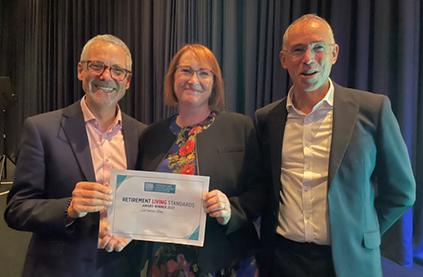Building a reliable income for life in decumulation for DC members
TPT’s Philip Smith explains the approach to risk mitigation in the design of our new ‘managed income for life’ default DC decumulation proposition.

Arguably, one of the most significant announcements George Osborne made on pensions during his tenure as Chancellor of the Exchequer was the declaration in his 2014 Budget speech: “Let me be clear: no one will have to buy an annuity”. The full set of Defined Contribution (DC) pensions-focused reforms went live in April 2015, giving DC pension savers unrestricted choice between income drawdown, annuity or cash at retirement. The era of ‘freedom and choice in pensions’ was born.
While this flexibility empowers retirees, it also places the responsibility and risk of managing retirement funds squarely on their shoulders. If things go wrong, it may well be too late for many older retirees to repair the damage. Employers and pension trustees play a crucial role in helping members navigate these challenges.
This challenge is only likely to grow in scale. In 2023, almost 700,000 Baby Boomers (born between 1946 and 1963) reached the current State Pension age of 66. And by 2030, more 20% of the UK population will be over 65.
Our proposition is based on simplicity, low cost and aims to remove the need to make complex decisions.
Facing into these challenges, TPT started designing a ‘managed income for life’ DC decumulation proposition, to provide a sustainable level of managed income and remove the need to take complex financial decisions. Whilst considering the design, we examined the key risks that DC members were exposed to at retirement, specifically: sustainability, inflation, investment (including sequencing), and longevity (and cognitive decline). Let’s take a look at each in turn and explain how we have mitigated them with our default DC decumulation offering:
1. Sustainability risk
If a DC member takes out too much in early retirement, the drawdown pot can be irreversibly and prematurely depleted. Many tools and rules of thumb help manage this. The best known is the 4% rule, which states that annual withdrawal amounts should not exceed 4% of the pot value on retirement. However, the FCA’s latest data shows that 40% of drawdown customers make regular withdrawals, totalling 8% or more of their pot value per year, posing significant sustainability risks.
We decided to focus on redesigning our default Target Date Fund (TDF) to enable members to transition seamlessly into income generation over their chosen retirement window, with the need to make minimal decisions. Asset allocation and income payout rates are managed on behalf of the member to target a sustainable income across the rest of their retirement, while ongoing exposure to growth assets provides potential for future increases.
Income is paid monthly, with payout rates reviewed annually to ensure sustainability. Income can be adjusted up and down to reflect economic conditions and investment returns. The end date of the income strategy is set at age 95, when members will be left with around two to three more years of payments if they still require an income.
2. Inflation risk
A recent Institute of Fiscal Studies paper, entitled ‘How does spending change through retirement?’, shows that pensioner expenditure ‘remains relatively constant in real terms throughout retirement, increasing slightly up to around age 80 and remaining flat or falling thereafter.’
Against this backdrop, TPT’s default TDF investment strategy was designed to deliver a retirement income that can maintain its real value with the review process overseen by the trustees each year.
Encouragingly, the long-term results of a similar retirement income approach indicate that it has been possible to deliver an income that maintains its real value, unlike the capped inflation payouts produced by defined benefit plans.
The annual review process is structured to ensure long-term sustainability. In times of market stress, annual payout rates may be adjusted, addressing the issue of investment risk.
3. Investment (and sequencing) risk
With many drawdown customers self-managing asset allocation and income, the risk of market volatility derailing carefully laid plans is real.
The design of our Managed Income for Life decumulation offering mitigates against sudden share price falls and lowers investment and sequencing risks by building in investment diversification. A portion of member funds could be in our Secure Income Fund, which is underpinned by private credit and secured financing, and our Real Assets Fund - invested in unlisted infrastructure. All are designed to provide additional income stability in times of stock market volatility. Because our assets generate a natural level of income, the need to sell shares is reduced, avoiding most of the sequencing risk.
4. Longevity (and cognitive decline) risk
Longevity risk remains a key challenge as it is impossible for members at retirement to accurately predict their own life expectancy. However, it's important for them to understand that there is a wide window and if they only plan for their longevity mid-point, then close to 50% will run out of money.
To address this, TPT offers an option to convert remaining savings into a guaranteed annuity between ages 75 and 80. Buying an annuity later in life provides a significantly higher income per pound invested, as insurers factor in shorter remaining lifespans and potential health conditions.
The annuity option offers members a guaranteed income in their final years. In this way, the risk of financial loss due to poor decision-making associated with cognitive decline as a result of the onset of dementia, Alzheimer’s, or other age-related mental conditions, is also mitigated. Today, one in six UK adults suffers from some form of dementia from age 80 onwards.
TPT’s new managed income solutions help mitigate the key retirement risks faced by DC members. They enable members to transition seamlessly into retirement, remaining invested in the same sophisticated default investment strategy whilst receiving regular, sustainable inflation-linked income. Members are fully supported with online guidance in their digital pension account, which simplifies decision-making and provides the option of protection against later-life cognitive decline through annuity purchase.
For more information on our DC scheme, visit our Defined Contribution page.
Related news & insights
-

TPT hires new Head of DC Distribution
TPT is pleased to announce the appointment of Adam Tudor as Head of DC Distribution. -

Pensions at Work 100
We’re excited to announce our involvement in a news-style programme in partnership with ITN Business and the Pensions and Lifetime Savings Association (PLSA) called ‘Pensions at Work 100’. -

We’ve won the Retirement Living Standards Award
We’re delighted to announce that we’ve won the Retirement Living Standards Award for our communications to support and engage Defined Contribution (DC) members with their pension savings. -

We're Pension Provider of the Year!
We’re delighted to have been named Pension Provider of the Year at the Money Age Awards 2023. The award recognised how we support our Defined Contribution members on their pension journey with a combination of online tools, compelling communications and fund choices.
